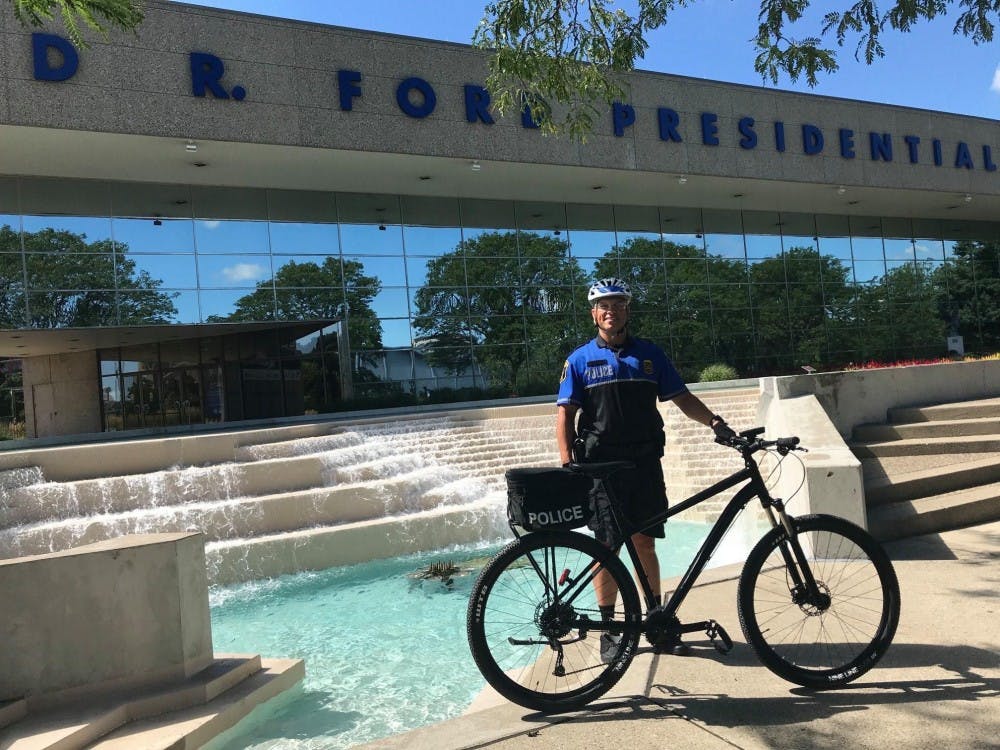Cops on wheels: CMU police use bike patrols to increase community policing efforts

Officer Scott Malloy, of CMUPD, poses for a photo in front of the Gerald R. Ford Presidential Museum in Grand Rapids. Malloy received training in Grand Rapids last month to become a certified bike patrol instructor. (Courtesy Photo | Central Michigan University Police Department)
When walking through Central Michigan University's campus, it's not out of the ordinary to see your fellow students riding their bikes to class. However, what you might not expect to see is police officers riding bikes through campus, too.
After one of its own officers received training last month to become a certified bike patrol instructor, CMU Police Department is increasing its presence of bike patrols around campus to assist in a newly-reconfigured community policing structure.
Officer Scott Malloy received training in Grand Rapids this summer along with a dozen officers from around the country to become a certified instructor of bike patrols. His certification makes him one of the few instructors in Michigan that can train police in bike patrols.
“It used to be difficult to find training around the state,” Malloy said. “Instructors were very limited, we couldn’t find anything in-state. So we decided I would train to become an instructor.”
A spot opened up in the week-long school in Grand Rapids, and Malloy eagerly signed up for the training. He was one of only three Michigan cops to complete the training, along with a Grand Rapids and Michigan State Police officer.
Once a police officer becomes a certified bike patrol training instructor, they are allowed to train other officers to become bike patrols. Malloy’s training now allows CMUPD to train not only its own officers but to help other agencies from around the state with training.
Becoming a certified bike patrol officer isn’t simply as easy as riding a bike, Malloy explained. In order to pass the training – and not all officers do, he said – a cop must pass tests on vehicular navigation, road safety and ascending curbs and flights of stairs.
“A lot of people can ride a bike, but this training is more difficult than that,” Malloy said. “Two people actually failed out (of the training). Just because you went to the training doesn’t mean you could actually become an instructor. There are high standards.”
Lt. Mike Sienkiewicz, one of CMUPD’s six certified bike patrol officers, said bike patrol can be more difficult than it looks.
“It sounds like a real simple concept, right? Just riding a bike,” he said. “But the saying that a lot of us use is, ‘It’s not as simple as riding a bike.’”
Sienkiewicz shared that bike patrol training can sometimes be dangerous. Once, during his training, Sienkiewicz had to get stitches when he was practicing descending 50 stairs and his leg slipped off a pedal, getting stuck in the gears.
“I had to get like 20 stitches,” he said. “But that’s why we train, we want to avoid those kinds of things.”
Officers must train to ascend and descend stairs and curbs on their bikes, as well as firearm skills, quick turns and crossover dismounts. They also train for a variety of bike patrol scenarios, including burglaries, traffic stops and dealing with emotionally disturbed persons.
Increased community policing
CMUPD is making a concerted effort this year to increase its bike patrol program, Malloy said, because of its added benefits to community policing.
Under newly-appointed Chief Larry Klaus, CMUPD is reconfiguring its community policing structure this year to immerse more police officers into the university community.
“Putting officers on bikes is a huge part of our community policing efforts,” Malloy said.
As officers riding their bikes through campus, they get a closer glimpse at student life – allowing them to get to know the campus community a little better. Bike patrols allow CMUPD to increase contact with students, which has a number of benefits for the police department.
“There are some places on campus you can’t get to by car, like the walkway down the middle of campus, so bike patrols allow you to get to areas you can’t normally get to,” Sienkiewicz said.
It also makes a great conversation starter between officers and pedestrians when police are patrolling campus on a bike, Sienkiewicz said. He recalled a time that he was patrolling a football tailgate when he was able to make conversation with someone who had the same bike he did.
“I’ve talked to people who have never seen a police officer on a bike before, so we got to stop and talk about that,” Malloy added. “It’s totally out of the ordinary for them.”
Seeing officers on bikes often results in more positive interactions between students and police, Malloy said.
"A lot of people have their earbuds in and they’re looking down on their phones," Malloy said. "But I have a little bell on my bike and as soon as I ring that bell and they hear that ‘ding ding,’ they immediately look up and smile. The bell makes them smile."
Because the bikes look a lot less aggressive than patrol vehicles do, it can take away some of the barriers for people who are dealing with police, Malloy said.
“We want to break down any anti-police rhetoric that exists on a national level,” Sienkiewicz said. “Some folks will come to CMU with that value placed on police, so this is our opportunity to show that police aren’t too bad. We’re being very intentional about that, and we see this as a tool to do that.”
Not to mention, the bike patrols are great for officers’ health and wellness, allowing police to “get out of the office and get some exercise,” Sienkiewicz said.
Low-cost alternative to patrols
Along with the increased community policing benefits, bike patrol also offers a zero-cost alternative to monitoring campus. There are no ongoing costs to bike patrols, as the bikes don’t require gas/maintenance like patrol vehicles do, Sienkiewicz said.
Most of the bikes used by CMUPD were purchased 20 years ago, at the start of the program, and all of them are still “running like brand new,” Sienkiewicz said. Any minor costs, like new bike patrol uniforms, comes from the department’s equipment budget.
In the coming years, if officer engagement stays high, CMUPD hopes to replace a bike or two every year.
“It’s a good program,” Malloy said. “Good for our officers and good for our community, and the cost is pretty minimal. We want to keep that going.”






